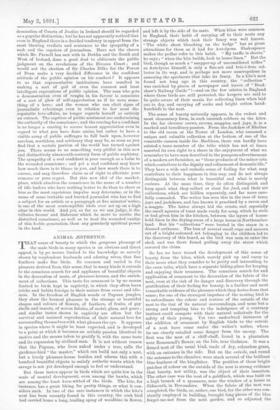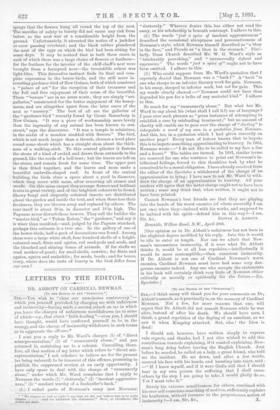ANIMAL ASTHETICS.
THAT sense of beauty to whicl the gorgeous plumage of the male birds in many species is an obvious and direct appeal, is by po means limited to the knowledge so naIvely shown by resplendent husbands and adoring wives, that fine -feathers make fine birds. So common and varied is the pleasure derived from this sense, that in many kinds it extends to the conscious search for and appliance of beautiful objects in the decoration of nests, of pleasure-houses, and the enrich- ment of collections. This taste for ornament is by no means limited to birds kept in captivity, in which they often learn tricks and habits foreign to their nature from ennui and idle- ness. In the freedom of English woods or Papuan jungles, they show the keenest pleasure in the strange or beautiful shapes and colours of flowers, of feathers, of fruits, of gay shells and insects, of woven fabrics, of metal, glass, and gems ; and similar tastes shown in captivity are often but the survival and maimed reproduction of their natural love for surrounding themselves with what pleases the eye. It appears in species where it might be least expected, and is developed to a point at which it becomes an artistic passion identical in motive and the means taken to gratify it, with the same taste -and its expression by civilised man. It is not without reason that the Papuan, who lives naked under a tree, calls the gardener-bird "the master," which can build not only a nest, but a lovely pleasure-house besides, and adorns this with a hundred beautiful objects to satisfy aesthetic wants which the savage is not yet developed enough to feel or understand.
But these tastes appear in birds which are quite low in the -scale of mental development, even among the hawks, which are among the least keen-witted of the birds. The kite, for instance, has a great liking for pretty things, or what it con- siders such. In two of the rare instances in which the kite's nest has been recently found in this country, the cock bird had carried home a long, trailing spray of woodbine in flower,
and left it by the side of its mate. When kites were common in England, their habit of carrying off to their nests any strange objects which took their fancy was well known. "The white sheet bleaching on the hedge" has as great attractions for them as it had for Autolycus. Shakespeare makes the pedlar refer to this habit. "My traffic is sheets," he says ; "when the kite builds, look to lesser linen." But the bird, though as much a "snapper-up of unconsidered trifles" as Autolycus himself, is only a fine-art and brie-a-brao col- lector in its way, and is perhaps not more unscrupulous in annexing the specimens that take its fancy. In a kite's nest found not long ago in this country, the " collection " was enriched by pieces of newspaper and leaves of " Brad- shaw's Railway Guide" !—and on the few estates in England where these birds are still protected, the keepers are said to be quite aware of their mania for collecting linen when laid out to dry, and carrying off socks and bright cotton hand- kerchiefs to the nest.
The sense of beauty naturally appears, in the rudest and most elementary form, in such uncouth robbers as the kites. In the far cleverer crows, ravens, magpies, and jays, it is a marked and hereditary passion. From the Jackdaw of Rheims to the old raven at the Tower of London, who amassed a unique and valuable collection at the bottom of one of the venerable cannon inside the Barbican, there can hardly have existed a tame member of the tribe which has not at times asserted its own right to a share in the enjoyment of what we remember to have seen described in the pompous advertisement of a modern art furnisher, as "those products of the minor arts which contribute to the dignity and refinement of domestic life." They have a wide and catholic sense of feeling for what may contribute to their happiness in this way, and do not always distinguish between what is beautiful and what is merely curious. At the same time, they do often distinguish and keep apart what they collect or steal for food, and their art collections, which are hidden separately, and far more care- fully concealed. The writer has seen this in the case of tame jays and jackdaws, and has known it practised by a raven and a magpie. The latter always hid the crusts, and especially the small squares of toast made ready for soup, which he stole or had given him in the kitchen, between the layers of house- hold linen in the drying-room of a large house in Northumber- land. But his " collections " were buried in the straw in a disused outhouse. The loss of several small cups and saucers out of a bright-coloured set belonging to the children led to the discovery of this hoard, as the bird was seen to enter the shed, and was there found pulling away the straw which covered the china.
So far, we have traced the development of this sense of beauty from the kites, which merely pick up and carry to their nests what they consider to be pretty and interesting, to the crow tribe, which have a separate hiding-place for keeping and enjoying their treasures. The conscious search for and application of ornament to the decoration of the fabric of the nest, even at the risk of its danger and discovery through the gratification of their feeling for beauty, is a further and most remarkable evidence of the pleasure which they derive from that sense ; for one of the strongest impulses of the nesting bird is to subordinate the colour and texture of the outside of the nest to the tint of its natural surroundings, and none but a strong and tempting bias to the indulgence of a contrary instinct could compete with their natural solicitude for the safety of their young. Yet two undoubted instances of the addition of ornament by English birds to the outside of a nest have come under the writer's notice, where its use clearly entailed some danger from the enemy. The first was the nest of a chiff-chaff, found in a plantation near Rosamond's Bower, on the Isis, near Godstow. It was a domed nest of the usual kind, made of dry, colourless grass, with an entrance in the side. But on the outside, and round the entrance to the chamber, were stuck several of the brilliant blue feathers of the kingfisher. The position of these bright patches of colour on the outside of the nest is strong evidence that beauty, not utility, was the object of their insertion. The other case was the nest of a goldfinch, which was built on a high branch of a sycamore, near the window of a house at Sidmouth, in Devonshire. When the fabric of the nest was completed, the birds, or, rather, one bird, for the other was con- stantly employed in building, brought long pieces of the blue forget-me-not from the next garden, and so adjusted the sprays that the flowers hung all round the top of the nest. The sacrifice of safety to beauty did not cause any risk from below, as the nest was at a considerable height from the ground. Unfortunately, it attracted the notice of a jackdaw or crow passing overhead ; and the black robber plundered the nest of the eggs on which the bird had been sitting for some days. It may be noticed that in both these cases, in each of which there was a large choice of flowers or feathers— for the feathers for the interior of the chiff-chaff's nest were brought from a farmyard near—the irresistible colour was light-blue. This decorative instinct finds its final and com- plete expression in the bower-birds, and the still more in- teresting gardener-bird of New Guinea, both of which construct a "palace of art" for the reception of their treasures and the full and free enjoyment of their sense of the beautiful. These " bowers " are in no sense nests ; they are simply "art- galleries," constructed for the better enjoyment of the honey- moon, and are altogether apart from the later cares of the nest or "nursery." The best of all are the galleries of the " gardener-bird " recently found by Count Rosenberg in New Guinea. "It was a piece of workmanship more lovely than the ingenuity of any animal has been known to con- struct," says the discoverer. "It was a temple in miniature, in the midst of a meadow studded with flowers." The bird, which is not much larger than a thrush, chooses a level place round some shrub which has a straight stem about the thick- ness of a walking-stick. To this central pilaster it fastens the stems of a kind of orchid, and draws them outwards to the ground, like the cords of a bell-tent; but the leaves are left on the stems, and remain fresh for some time. The upper part is then fitted together, and the leaves and moss make a beautiful umbrella-shaped roof. In front of the central building, the birds clear a space about a yard in diameter, which they cover with moss, after removing all stones and weeds. On this moss carpet they arrange flowers and brilliant fruits in great variety, and of the brightest colours to be found. Showy fungi and elegantly coloured insects are distributed about the garden and inside the tent, and when these lose their freshness, they are thrown away and replaced by others. The tent itself is about 39 in. in diameter and 18 in. high. The Papuans never disturb these bowers. They call the builder the "master-bird," or " Tukan Robon," the "gardener," and say it is wiser than mankind,—and, judged by the Papuan standard, perhaps this estimate is a true one. In the gallery of one of the bower-birds, half-a-peck of decorations was found. Among these were a large white shell, four hundred shells of a bright- coloured snail, flints and agates, red seed-pods and seeds, and the bleached and shining bones of animals. If for shells we read mother-of-pearl; for snail-shells, cowries ; for flints and agates, agates and malachite ; for seeds, beads; and for bones, ivory, where does the taste of beauty in the bird differ from our own P







































 Previous page
Previous page